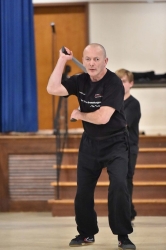
This time we’re going to discuss the main long blades of Dekiti Tirsia Siradas (DTS) as well as other miscellaneous weapons.
Negros Island, the home of Grandmaster Jerson “Nene” Tortal is in the Visayan region of the Philippines. That being the case, we will use the Illolngo term for the weapons when appropriate.
Two Blades commonly found in DTS
The first up is the Talibong, (my favorite long blade). The overall length of the Talibong is usually 28” (Nene has one which is 36”) with a 6” to 8” handle and plenty of blade for business.) The primary function of the Talibong would be for thrusting. By using the 12 strikes sengetti (thrusting) style, the DTS practitioner would seek out the vital points on their opponent and use the tip of the weapon to dispatch them. This form of attack would also be very useful against armored opponents, such as the Spaniards who occupied the Philippines,( mostly the coastal regions) for almost four hundred years. The Talibong was designed as a fighting sword, but as with many things in the Philippines, it has many purposes. The style of the blade may differ slightly from town to town however it usually would start with the hilt 1” to 1 1/2 “ expanding down the length to around 2 1/2″ then curving up to the tip, as well as curving slightly in on the backside for reverse cutting.
Next on the list is the Ginunting. The Ginunting’s primary function is slashing through your opponent’s defenses, defusing his attack and finishing the encounter. 26.5” long with a 20” curved blade this is the blade adopted by the Filippino Military who to this day still has to maintain order and track down and deal with terrorists and outlaws in the towns and jungles on many of the Isles of the Philippines. Focusing more on the slashing aspect of the 12 strikes the east. Probably the quickest way to work with a ginunting is to imagine a big X in the air in front of you and practice two downward strokes and then opposite to the two upward strokes. The feel of the weapon is slightly heavier than a machete with a bit of the weight towards the tip, again to aid in the forward motion of the slash. On the utilitarian side, the same virtues that make it a great combat weapon, also make it very useful too when you are maneuvering through the overgrowth and jungle.
Alternative Weapons found in DTS
Now we’ll talk about one of the more interesting weapons in Dekiti Tirsia Siradas. The PR-24, otherwise known as the Tonfa or the short crutch in the Chinese arts. This unique weapon is based on the movements of the reverse grip Baston, starting with the similarity of the 12 strikes but now with a handle. In DTS, it is held with the length of the shaft along the forearm, rarely does the DTS practitioner extend the long shaft, Defenses can be done against a variety of weapons from long Baston “baseball bat” to all bladed weapons usually using the reverse countering maneuver with variations on joint locking and manipulation.
One more for you today, and It’s time to get all Rick Grimes. The hand ax or hatchet is another one of the preferred weapons of DTS, as much for its heftiness as for its utilitarian purposes. Short shaft (hatchet) or long shaft (ax) are both trained extensively in the system. Used as much for functional weight training as for combat, these DTS tools come in as handy for chopping wood as they do at training Kali.
Training in Dekiti Tirsia Siradas is like peeling back the layers of an onion. However, if you can grasp the core concepts of the system you begin to see that anything you can pick up can become a weapon for protection.
Editor’s Note: Ready to learn more about the unique weapons found in Dekiti Tirsia Siradas? Be sure to also check out part 1!
- Shaolin Kung Fu: The Original Mixed Martial Art - September 5, 2025
- The Kwan Dao: A Legendary Chinese Kung Fu Weapon from Battlefield to Modern Practice - August 29, 2025
- Book Review ; Wrath of the Dragon byJohn Little - August 8, 2025

Leave a Reply